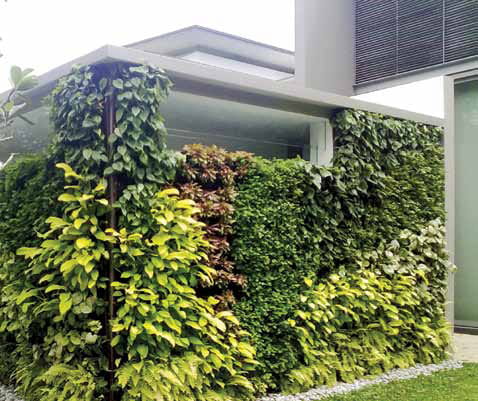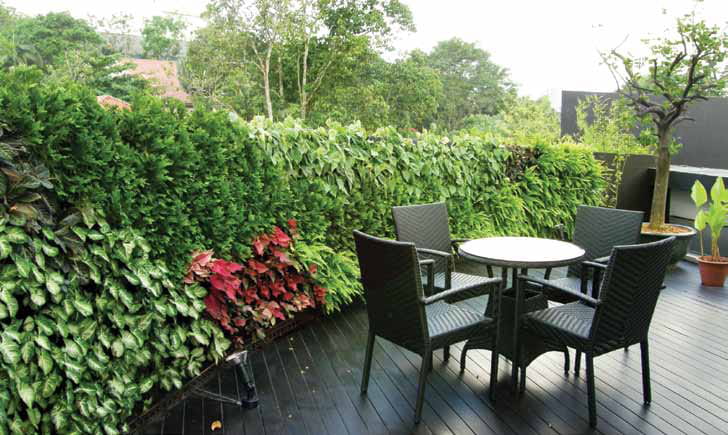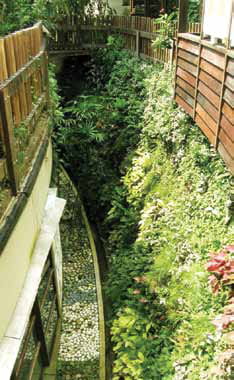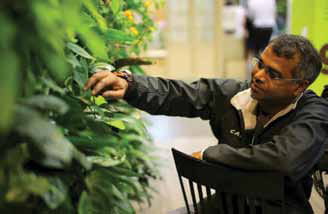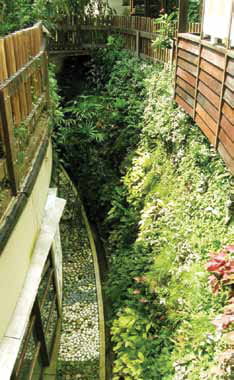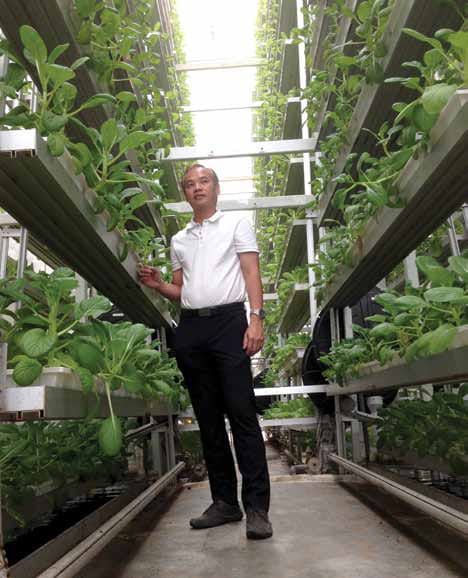Stories > Greening Out Of The Box
Greening Out Of The Box
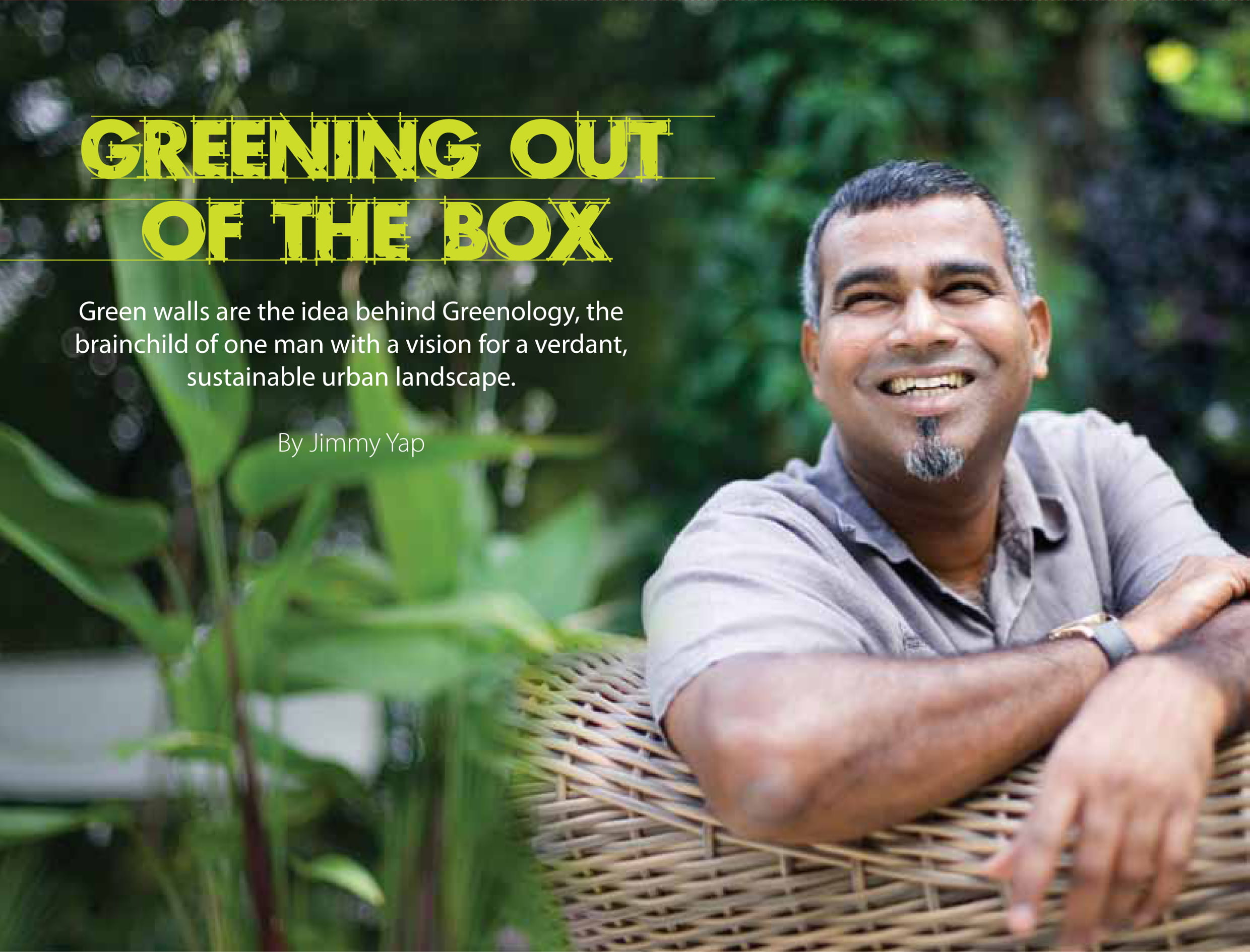
ingaporean Veera Sekaran had a vision. He wanted lush greenery to soften the city’s concrete and glass-and-steel edifices through the innovative use of walls and roofs.The former assistant curator at the Singapore Zoo and Night Safari, and the man involved in the greening of Changi Airport from 2002 to 2004, wanted to bring the garden into the city and into the heart of the home.
So he set up Greenology to spread the concept of urban ‘green walls.’ A green wall is found in nature where plants grow naturally on vertical surfaces. Using this concept, plants are introduced into compact living spaces — a vital point as more than half the world’s population now live in cities. And this is a trend, the World Health Organisation says is going to continue, with seven out of every 10people living in cities by 2050.
Along with this upward trend come the challenges of developing conducive living environments for people living vertically.While efficient infrastructure helps to keep things in the city moving smoothly,it is also important to allow nature to be part of the urban landscape.
Aesthetically pleasing, green walls are an innovative solution to urban landscaping and are an increasingly popular way of beautifying concrete jungles. It also paves the way for sky farming to mitigate any future food shortages.
The vertical garden concept was developed by French botanist Patrick Blanc, who patented it in 1988. He has several projects in many cities around the world, including Singapore, such as the Rainforest Rhapsody at 6 Battery Road, which was completed in 2011, and The Lookout at Parbury Avenue, which will be ready in 2016.
A Green Thumb
Veera saw a business opportunity in the greening of cities, and since setting up his business in 2008 in Changi Village, he has been transforming walls in Australia,Japan, India, Indonesia, Malaysia and the United Arab Emirates. It’s not a difficult notion to sell, but certainly one that requires know-how to execute well.
The green wall — or living wall — is a cost-effective idea that requires minimal maintenance; just about any wall can support the weight of a vertical garden weighing approximately 30kg or less per square metre. Plants or vegetables can be grown on most surfaces, with or without soil. The basic structure comprises a constructed frame secured with brackets, which is then mounted on the wall. A simple irrigation system provides nutrients; plastic sheets within the structure are fitted with fabric or carpet padding that’s kept moist to enable the plants to grow. The choice of vegetation is dependant on how much sunlight it needs.
While Veera’s business is scaling new heights constantly, it took sometime for it to take root. The first-time entrepreneur lost money in the first two years of operation — at one point he had a credit card debt of S$150,000 of the company’s bills. But his belief in his system was unshakable.
Greenology’s big break came when it was commissioned to build a green wall for the Formula 1 Pit Building in 2010.Things were looking up for Veera and it appeared that the business had turned the corner. However, towards the end of that year he contracted a rare medical condition, Parsonage-Turner syndrome.“It rendered both my arms unusable.They were paralysed, and for six months I couldn’t eat or drink. It also caused tremendous pain.” Because it is so rare,his doctors were uncertain about how it should be treated.
This ornamental garden is packed into a dense two-square metres of vertical space in the balcony of a Housing Development Board apartment in Bishan. The self-contained mobile unit with automated irrigation and integrated drainage features kitchen herbs such as chilli, Thai basil, sweet basil, dill and curry leaf.
Undaunted, Veera went back to work and the symptoms mysteriously disappeared; he slowly recovered over a period of several months with traces of the occasional discomfort. He believes that his work with plants helped him in his recovery.
A vertical garden concept softens the hardness of the boundary fence of this Belmont Road residence, extending the lush greenery beyond the garden. It creates a green sanctuary to unwind in and be with nature.
“I wanted the intellectual property to stay in Singapore, to improve on it and bring the brand out to the world.”
Developing the Concept
During those six months, Veera had the opportunity to reflect on how he could refine his Greenology Vertical Greenery(GVG) system. “That was the period I had time to think. I created panels that were lighter yet durable. Green wall systems available in the market were expensive, going for between S$1,500and S$2,000 per square metre. And they didn’t necessarily work. Only people with deep pockets could afford them, and they only looked good fora short period of time. They were not sustainable,” Veera explained.
The GVG uses GMatrix™, an engineered growing media (no soil is used), a specially designed frame,an exterior mesh, and a fabric incorporating proprietary GNanofibre™ technology. It was a product of months of trial and error. “I drove around industrial estates looking for material and I eventually engineered my own frame system,” he recalled. The company also designed the Greenology LED Grow Lights™ for optimal plant growth.
According to Veera, the GVG is a better-engineered solution for its cost effectiveness compared to existing commercial models. It is designed to replicate natural growth patterns of plants based on the principles of botany,using proprietary innovation, recyclable materials, and a timer-activated irrigation system which boasts one of the lowest water consumption rates in the world. It is a living eco-system and art piece that evolves over time.
Greenology’s green walls area esthetically pleasing thanks to the sheer variety of plants on one wall. “But the beauty is, even the smallest urban space can be greened,” enthused Veera.His vertical system starts at $550 per square metre.
“Very few green wall systems can offer that diversity because different plants require different growing conditions. You need to understand how they thrive together in an ecosystem.It takes a team with cross-disciplinary expertise and experience in botanical science, horticulture, engineering and landscape architecture to build a green wall for an urban environment.Veera guards Greenology’s intellectual property by ensuring its various components are assembled at its Changi premises instead of in a country where production costs are low.
The vertical greenery blends this staircase entrance to the basement of a landed property on Oriole Crescent with the rest of the landscaped garden. It’s the perfect disguise for a standalone unit that might otherwise look odd in the property grounds.
“I drove around industrial estates looking for material and I eventually engineered my own frame system.”

The vertical garden that envelopes this rooftop open space of a private property on Caldecott Close transforms it into an lush setting for weekend rendezvous or dinner parties.
Veera feels at home whenever he’s surrounded by greenery. His affinity with plants has reaped verdant rewards.
“I had a natural affinity for plants. I could understand,by looking and touching them, what was ailing them and what they needed to do to grow well.”
Veera rejected a take-over bid by a French company because he wanted to be independent. “I wanted the intellectual property to stay in Singapore, to improve on it and bring the brand out to the world.”
Socially Responsible
While his handiwork can be seen on the walls of several international companies in Singapore — Estee Lauder, The F1Pit Building and the Bread Talk Group,among others — he also takes the message out to schools.
“In our school projects, for example,we have hosted several hands-on sessions and designed learning workshops, where we introduce green walls to teach about nature and science and to show how biodiversity can help mitigate the ‘urban heat island effect’ and combat climate change.”
Greenology prides itself as a socially responsible company, hiring senior citizens and ex-offenders from its inception. A supporter of the Yellow Ribbon Project, Veera believes in giving them a second chance in life to help them ease their way back into mainstream society. Over the past five years, Greenology has employed14 ex-convicts.
“It’s the doorway for them to reintegrate into society. Their outlook changes and they appear to become calmer and more subdued whilst working with plants. It is a good transition for many of them.” Many ex offenders move on to other jobs after leaving Greenology. “We are glad that the ex-inmates were very happy with the opportunity to work with us and to start life afresh. We are still looking for potential candidates who will stay and make a career in this industry.”
A Tough Start
Veera’s compassionate disposition stems from an impoverished childhood. He was just five years old when his father,a labourer, died and left his housewife mother the burden of raising eight children. Money was scarce. In primary school, a paper shopping bag became his school bag; textbooks were always secondhand and he wrote using pencil stubs discarded by his classmates.
At critical points during his schooling days, several teachers intervened to lend him a helping hand to ensure he could continue going to school. He was offered a place at the National University of Singapore but didn’t have the finances to pursue this course. An opportune meeting with Haridass Ajaib, a lawyer, ata social event changed the course of his life. Veera had mentioned to Haridass he could ill afford the university fees. The man said, “You sign up, I will pay for it.”Haridass was true to his word.
At university, Veera majored in biology. “I had a natural affinity for plants. I could understand, by looking and touching them, what was ailing them and what they needed to grow well. Also, I had a knack for remembering Latin names. I used to help my father tend our small vegetable plot when I very young, and that probably had an impact on my career.”
The green wall that clads the steep embankment surrounding this residential property on Wilby Road serves both practical and aesthetic functions — it stabilises the retaining wall to prevent further soil subsidence and immerses the home in a botanical garden.
Ever grateful, Veera makes it a point to help the less fortunate. “I told myself that I would help others in need where possible, and I want to start an education fund in Haridass’ name.”
After he graduated, Veera wanted to repay Haridass, but was told by the lawyer: “No need. Go help someone else.”
The sky is the limit for Jack Ng’s vertical farming concept. Talks are currently underway to export the vertical farming idea to countries like China.
Ng, who started Sky Greens at the cost of S$1 million, said he foresaw Singapore’s dependence on imported food increasing even more owing to population growth and decreasing farm land. He wanted to “create a farming method that minimises the use of resources like land, energy and water; has a low carbon footprint, yet produces a high yield.”
Despite his limited knowledge of agriculture, Ng put to use his 30years of experience in engineering to come up with the innovative concept of vertical farming. He designed an energy-efficient modular A-frame vertical contraption comprising rotating racks powered by a waterwheel. Energy consumption is very low — equivalent to a 60-watt bulb.Each tower is affixed with 26 troughs,each holding 48 potted vegetable plants. These plants obtain moisture by being dipped in water. For sunlight, the hydraulic-operated rack rotates the plants from the bottom to the top of the A-frame thrice daily.
In 2011, based on the patented prototype, 19 towers were piloted at the Sembawang Research Centre. Following the successful pilot project, Sky Greens went commercial in 2012.
Today, it has 400 towers housed in outdoor greenhouses at the Lim Chu Kang Agro technology Park that produce one tonne of vegetables daily. This includes Chinese cabbage and baby bak choy sold at selected NTUC FairPrice Finest supermarkets.
Each vertical tower costs S$15,000 to build and has a footprint of six square metres. It yields a harvest equivalent to 25 square metres of conventional farm. Given its bounty, Sky Greens is targeting to have 2,000 vertical towers by the end of 2014 that will see production spike 10-fold from the current one tonne to ten tonnes. This will boost Singapore’s production of leafy greens as only 7% of vegetables consumed are currently locally grown.
With the threat of global warming hanging over conventional farming methods, Ng sees vertical farming as a viable solution beyond Singapore and hopes to spread the idea to Southeast Asia. Says Ng, “I believe Sky Greens will be a global company in five years time. We intend to work with the right partners with a similar vision of sustainable urban living.”

